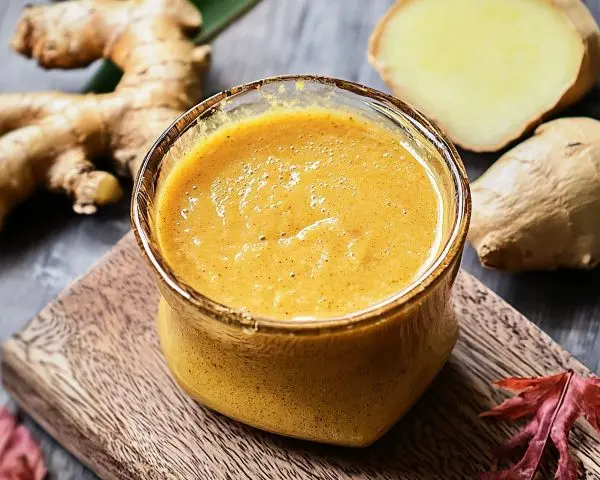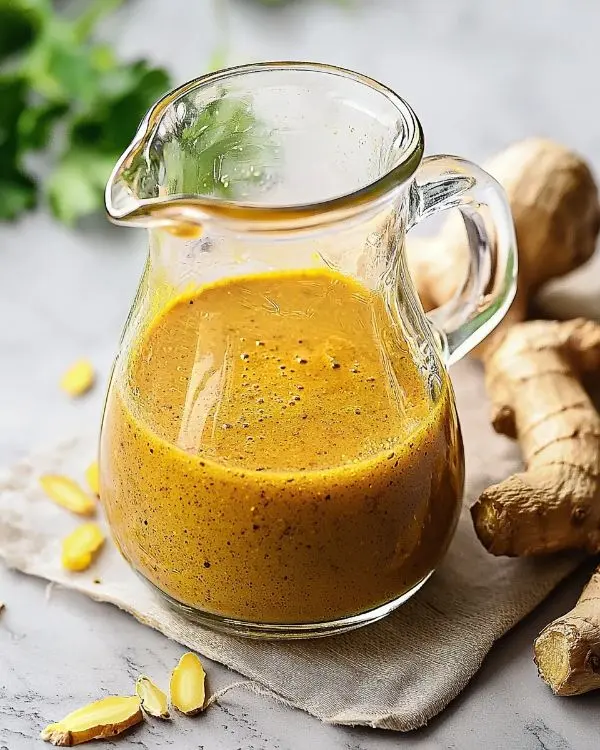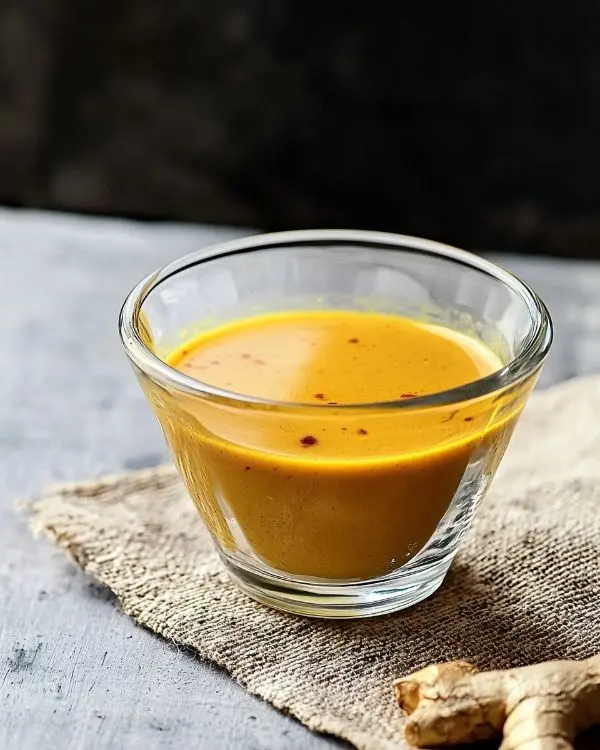Japanese Ginger Salad Dressing made with fresh ginger, carrots & coconut aminos. Get restaurant-quality flavor at home with this easy recipe.
Hi, I’m Linda, and welcome to Tasty at Home—where bold flavors meet everyday kitchens. Last spring, I walked into my local sushi spot craving their famous house salad.
You know the one—crisp iceberg lettuce drowning in that magical orange-tinted dressing that somehow tastes like sunshine and comfort rolled into one. Well, after three weeks of ordering takeout just for that salad, I decided enough was enough.
I spent the next month testing Japanese Ginger Salad Dressing recipes in my kitchen. Let me tell you, I went through more ginger root than a health food store during flu season. Some attempts tasted like drinking pickle juice.
Others resembled baby food more than salad dressing. But finally, after burning through my blender warranty and questioning my life choices, I cracked the code.
Table of Contents
What Makes This Japanese Ginger Salad Dressing Special

This isn’t your typical ginger salad dressings recipe. Instead of relying on mayonnaise or heavy cream, we build depth through fresh carrots and celery. These vegetables create a naturally creamy base while adding subtle sweetness. Additionally, coconut aminos replace traditional soy sauce, making this recipe Whole30-friendly and AIP-compliant.
The secret lies in the balance. Fresh ginger provides heat without overwhelming the palate. Rice vinegar adds brightness that cuts through rich dishes. Furthermore, avocado oil creates the silky texture you expect from restaurant versions.
Essential Ingredients
| Ingredient | Amount | Purpose |
|---|---|---|
| Carrots (peeled, chopped) | 1 ½ cups | Natural sweetness and body |
| Celery stalks (chopped) | 2 stalks | Adds depth and freshness |
| Yellow onion (chopped) | ¼ medium | Builds savory foundation |
| Fresh ginger (peeled, chopped) | 2 tablespoons | Star flavor component |
| Avocado oil | ½ cup + 2 tablespoons | Creates creamy texture |
| Coconut aminos | ¼ cup | Umami depth |
| Rice vinegar | 3 tablespoons | Brightness and tang |
| Coconut sugar | 2 teaspoons | Balances acidity |
| Sea salt | ¾ teaspoon | Enhances all flavors |
| Black pepper | ¼ teaspoon | Subtle heat |
Bold Add-ins and Substitutions
Transform your classic salad dressing with these creative variations. Swap rice vinegar for apple cider vinegar if following AIP protocols. Skip the coconut sugar for strict Whole30 compliance. For international readers, tamari works beautifully instead of coconut aminos.
Shopping Tips for Best Japanese Ginger Salad Results
Choose firm, bright orange carrots without soft spots. Fresh ginger should feel heavy with smooth, taut skin. Avoid dried, wrinkled pieces that indicate age. Moreover, opt for organic celery when possible, as conventional varieties often carry pesticide residue.
Quality avocado oil makes a tremendous difference in texture. Look for cold-pressed versions in dark bottles. These oils maintain their nutritional benefits and create the smoothest dressing consistency.
Equipment and Step-by-Step Instructions
Essential Equipment
You’ll need a high-speed blender for best results. Food processors work too, though they create a slightly grainier texture. A sharp knife and cutting board are necessary for prep work. Additionally, keep measuring cups handy for accuracy.
How to Make Japanese Ginger Salad
Step 1: Prep Your Vegetables
Start by peeling and roughly chopping your carrots into one-inch pieces. This size ensures even blending without overworking your machine. Next, chop celery stalks, removing any tough strings. Quarter your onion portion and set aside.
Step 2: Handle the Ginger Like a Pro
Here’s where I made my biggest mistake initially. I tried using a spoon to peel ginger, which wasted precious flesh. Instead, use a sharp knife to remove skin efficiently. Chop ginger into small pieces to help your blender process it smoothly.
Step 3: Blend to Perfection
Add all ingredients to your high-speed blender in this order: liquids first, then soft vegetables, finally ginger. This layering prevents air pockets that create uneven blending. Blend for 60-90 seconds until completely smooth.
The finished dressing should coat a spoon without being too thick. If consistency seems thin, add more carrots. Too thick? A splash of water works wonders.
Step 4: Season and Adjust
Taste your creation and adjust seasonings as needed. More salt brightens flavors. Additional vinegar adds tang. An extra pinch of coconut sugar balances sharp notes beautifully.

Expert Tips for Restaurant-Quality Results
Pro Techniques from the Masters
Julia Child always emphasized the importance of proper seasoning balance. She would taste, adjust, and taste again until flavors sang in harmony. Apply this philosophy to your Japanese Ginger Salad Dressing. Furthermore, Thomas Keller taught us that great cooking comes from understanding your ingredients. Fresh ginger varies in potency, so start conservatively and build flavor gradually.
Storage and Make-Ahead Wisdom
| Storage Method | Duration | Best Practices |
|---|---|---|
| Refrigerator | 7-10 days | Shake before use |
| Freezer | 3 months | Thaw overnight |
| Room temperature | 2 hours max | Discard after |
Store your dressing in glass containers whenever possible. Mason jars work beautifully and make portion control easy. The dressing naturally separates, so vigorous shaking before use is normal and expected.
Creative Variations to Try
Southwest Twist: Add ½ jalapeño and ¼ cup cilantro for heat and herbaceous notes.
Tropical Paradise: Include 2 tablespoons pineapple juice and ¼ teaspoon red pepper flakes.
Autumn Harvest: Substitute half the carrots with roasted butternut squash for Thanksgiving depth.
Mediterranean Fusion: Add 1 tablespoon tahini and reduce oil by 1 tablespoon.
Citrus Celebration: Include 1 tablespoon fresh orange zest for bright, summery notes.
Serving Suggestions and Perfect Pairings
This versatile dressing shines on more than just green salads. Drizzle over grilled salmon for an instant flavor upgrade. Use as a marinade for chicken thighs before roasting. Additionally, it makes an excellent dipping sauce for fresh vegetables or spring rolls.
Consider pairing with my fluffy cottage cheese blueberry cloud bread for a light lunch combination. The creamy, tangy flavors complement each other beautifully.
For heartier meals, serve alongside creamy hamburger potato soup. The bright, fresh dressing cuts through rich, comforting flavors perfectly.
American Holiday Applications
Transform your Thanksgiving table by serving this dressing alongside traditional macaroni salad. The bright, fresh flavors provide welcome contrast to heavy holiday dishes. Moreover, the beautiful orange color adds visual appeal to autumn spreads.
During summer barbecues, use this aioli-style dressing as a burger condiment. It elevates simple grilled patties into gourmet experiences that guests remember long after the party ends.
Japanese Ginger Salad FAQs
What is in Japanese ginger dressing?
Japanese ginger dressing typically contains fresh ginger, carrots, onion, oil, vinegar, and seasonings that create its signature orange color and sweet-tangy flavor profile.
What is Japanese ginger sauce made of?
Japanese ginger sauce combines fresh ginger root with vegetables like carrots and celery, plus oil, vinegar, and umami-rich ingredients like coconut aminos or soy sauce for depth.
What is Japanese dressing made of?
Japanese dressing varies by style, but ginger versions use fresh ginger, root vegetables for sweetness, neutral oil, rice vinegar, and seasonings to achieve their characteristic taste and texture.
How to make simple ginger dressing?
Simple ginger dressing requires blending fresh ginger with oil, vinegar, a touch of sweetener, and salt until smooth – though restaurant-style versions include carrots and onion for complexity.
Common Troubleshooting Solutions

Dressing Too Thin: Add more chopped carrots and blend again. Carrots provide natural thickening without compromising flavor balance.
Overpowering Ginger Heat: Balance with additional coconut sugar or rice vinegar. Sometimes a pinch of salt helps tame excessive spiciness too.
Grainy Texture: Your blender needs more time or higher speed. Alternatively, strain the dressing through fine mesh if necessary.
Separation Issues: This is completely normal. Homemade dressings lack commercial emulsifiers, so vigorous shaking before use solves the problem.
Maximizing Nutritional Benefits
Fresh ginger provides anti-inflammatory compounds that support digestive health. Carrots contribute beta-carotene for eye health and immune function. Moreover, avocado oil supplies healthy monounsaturated fats that help nutrient absorption.
This dressing transforms simple vegetables into nutrient-dense meals. Research from the Harvard School of Public Health confirms that consuming diverse vegetables with healthy fats improves overall nutrition absorption.
Consider serving over mixed greens with my creamy chicken and rice soup for a complete, satisfying meal that nourishes your body and soul.
Final Thoughts and Your Next Steps
Creating restaurant-quality Japanese Ginger Salad Dressing at home isn’t rocket science—it just requires understanding how flavors work together. This recipe gives you that perfect balance of sweet, tangy, and spicy that makes every salad special.
The beauty of homemade dressing lies in customization. Start with this base recipe, then adjust according to your preferences. Want more heat? Add extra ginger. Prefer sweeter notes? Increase coconut sugar slightly.
I encourage you to make this dressing your own. Try serving it alongside my creamy roasted garlic tomato soup for a comforting meal combination. Or surprise your family with mummy brownies and a fresh salad dressed with this incredible creation.
Share your variations and results—I love seeing how creative home cooks adapt recipes to suit their families. Tag me on social media or leave a comment below. Your feedback helps improve future recipes and inspires other home cooks to experiment fearlessly.
Remember, every great meal starts with quality ingredients and a willingness to try something new. This Japanese Ginger Salad Dressing recipe opens doors to countless delicious possibilities in your kitchen.

Japanese Ginger Salad Dressing
Equipment
- High-speed blender
- Food processor
- Knife
- Cutting board
- measuring cups
Ingredients
Main Ingredients
- 1 ½ cups carrots peeled, chopped
- 2 stalks celery chopped
- ¼ medium yellow onion chopped
- 2 tablespoons fresh ginger peeled, chopped
- ½ cup + 2 tablespoons avocado oil
- ¼ cup coconut aminos
- 3 tablespoons rice vinegar
- 2 teaspoons coconut sugar
- ¾ teaspoon sea salt
- ¼ teaspoon black pepper
Instructions
- Peel and roughly chop carrots into 1-inch pieces. Chop celery and quarter the onion.
- Peel and chop fresh ginger into small pieces for easier blending.
- Add all ingredients to a high-speed blender: liquids first, soft vegetables next, and ginger last. Blend 60-90 seconds until smooth.
- Taste and adjust seasonings with salt, vinegar, or coconut sugar as desired.

